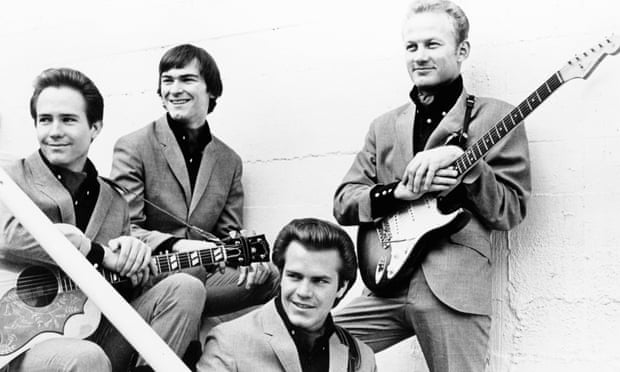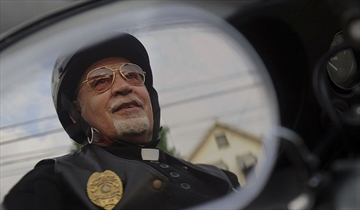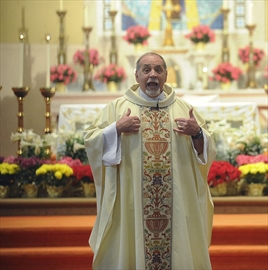During the reign of Benedict XVI, blogging became a mighty instrument in the hands of conservative Catholics. But the medium soon revealed a darker side
A fortnight ago, Pope Francis appointed Fr Robert Barron, rector of Mundelein seminary in Chicago, to be a new auxiliary bishop for the Archdiocese of Los Angeles. The news was greeted with little explosions of delight from conservative-leaning Catholics all over Twitter, including many from Britain. Why?
It wasn’t just because Fr Barron, 55, is himself rather conservative theologically, though he’d prefer to think of himself as simply orthodox. That wouldn’t be big news: plenty of conservative priests get made bishops, even under this supposedly “liberal” Pope (though not so often in England and Wales).
No: Twitter and the blogosphere were excited because Fr Barron is famous. He runs “Word on Fire Ministries”, which sounds to a Brit like an outfit run by an orange-haired US televangelist or one of those pop-up Nigerian “prosperity gospel” churches. He hosts Word on Fire with Father Barron, a half-hour show that airs nationally on WGN America, making him the first Catholic priest to have his own regular television programme on a national commercial channel since Fulton Sheen in the 1950s.
Word on Fire also makes programmes and DVDs for EWTN, the Catholic television network founded by Mother Angelica, and Fr Barron has a weekly radio programme called – you guessed it – Word on Fire. He pops up on NBC and Fox News as a Catholic commentator and writes lots of articles for Catholic publications, including this one. So he’s a media priest, and one who can call on expert advice: his brother John is a former editor-in-chief of the Chicago Sun-Times. (Incidentally, Fr Robert Sirico, distinguished founder of the Acton Institute for the Study of Religion and Liberty, also has a brother in the media: Tony Sirico, the mobster-turned-actor who played Paulie “Walnuts” Gualtieri in The Sopranos.)
But I digress. Robert Barron is not just a television evangelist: he is the first Catholic priest who has truly mastered new media. He blogs; he podcasts; he has a YouTube channel. He even compiles what are known in the trade as “listicles”. For example, “Father Barron’s seven tips for New Evangelisation”. Number Two is “You’ve got to be a person of ardour” and quotes Aristotle’s line that “people only really listen to an excited speaker”. It’s not unusual for Fr Barron to quote Aristotle or Aquinas: he is a professor of systematic theology whose doctoral thesis was “A Study of the De potentia of Thomas Aquinas in Light of the Dogmatik of Paul Tillich”.
Fr Barron’s final tip is to use the new media. He tells his students: “Know it; use it; it’s in your blood. Your generation grew up with this. You grew up with computers, so use them and don’t be afraid of technology.”
Good advice, but I’d be surprised if Chicago seminarians are at all afraid of technology. Young, devout Catholics are, paradoxically, both more conservative theologically than their predecessors and more tech-savvy than liberal believers, possibly because the latter tend to be older. The same is true of Protestantism, now dominated by digitally resourceful Pentecostalists, and perhaps also of Islam. Generally, conservative religion is more dynamic than liberal religion.
But let’s stick with the Church. The internet is a mighty instrument in the hands of conservative and traditionalist Catholics. They have used it to disrupt the power structure envisaged by enthusiasts for the Second Vatican Council, in which enlightened bishops would work through priests and pastoral assistants to implement justice and peace.
You’ll have heard of “the Catholic blogosphere”. It reached its heyday during the reign of Benedict XVI, when it was dominated by supporters of his liturgical reforms – in particular, the removal of restrictions on celebrating the Tridentine Mass.
During those years I wrote a blog for The Daily Telegraph called Holy Smoke. I had no idea it would take off in the way it did: some posts attracted 100,000 page views. To begin with, it was a way of letting off steam. As a young man I’d been tortured by the caterwauling of “folk Masses”. As a religion reporter in the early 1990s I was driven mad by the speak-your-weight lefty platitudes of the Bishops’ Conference of England and Wales, and the spendthrift incompetence of its secretariat.
Payback time! Here was an opportunity to tease the occupants of Eccleston Square, its headquarters, secure in the knowledge that they wouldn’t answer back. Blogs don’t offer much in the way of right to reply and, anyway, their press officers were far too snooty to mount a counter-offensive.
Then came Summorum Pontificum, in which Pope Benedict gave traditionalists everything they could wish for. This woke the bishops from their decades-long slumber. They were horrified by the power it handed to their least favourite priests and lay people. Certain bishops set about blocking the implementation of the Holy Father’s instructions by – it seemed to me – wilfully misinterpreting them.
Holy Smoke now had a mission: to record every attempt to suppress the Extraordinary Form and to make sure Rome knew about it. My teasing became obsessive – but, gosh, it was fun. I waged a joyous campaign against Bishop Arthur Roche of Leeds, who I thought had been particularly unhelpful, shall we say. Someone found a Facebook picture showing the bishop wearing a multi-coloured knitted beanie at a youth event. So that accompanied every blog post about him.
I also invented a “backstory” for the poor man. Before ordination, he’d been a figure skater, but was cruelly cheated of the north-west regional championship when things went wrong at the finals in Blackpool Tower. Oh, and his portly figure wasexplained by his passion for Cinnabons, a massively calorific, syrup-drenched American snack that briefly caught on over here.
I described vans loaded with Cinnabons trundling up to the bishop’s palace every week; to my delight, Louise Mensch, then a mischievous Tory MP, helped spread the stories of “Uncle Arthur” and his favourite pastries on Twitter. All very childish, you may think, but that was nothing compared to the conversations taking place “below the line” on Holy Smoke.
Some readers seemed to spend their whole lives in the threads, bickering and gossiping under pseudonyms. Many were traditionalist Catholics thrilled by the opportunity to settle scores after years of being ignored by control-freak trendy priests. One or two had inside information about the “Magic Circle” of ambitious liberal bishops and monsignors who, despite their opposition to the Pope’s vision of liturgy, mysteriously kept landing plum jobs.
The problem was that the conversations kept turning nasty. The blog was invaded by sneering atheists and – far more damaging – far-right Catholics raging against Jews and “faggots”. I still shudder at the mention of one commenter, a neo-fascist with a shaky grasp of English; in the end we had to block his IP address, whereupon he started up his own blog. It’s still going. As I write, he is fulminating against “Frankie the Evil Clown” and his cohort of “satanic criminals”.
Such people were easy to dismiss, but what about Catholic bloggers who dabbled more gently in conspiracy theories? A lot of my blog’s traffic was driven by devout Americans who worried about a homosexual mafia in the Vatican. As the “Vatileaks” scandal revealed, there was an element of truth to this, just as there was in my speculation about senior liberal English churchmen twisting arms in Rome to secure “jobs for the boys”. But their outpourings did little to improve the reputation of the Catholic blogosphere.
Perhaps it was just as well that the election of Pope Francis took the wind out of our sails. By 2013, one-man blogs in general were in any case flagging. Their authors, myself included, were exhausted by the pressure to serve up a daily dish of sarcasm and spiky opinion. And there was no money it in. Even the Telegraph couldn’t make a profit out of Holy Smoke’s traffic. Those hundreds of thousands of hits were “empty calories”, a social media expert told me.
The English bishops – one of whom had put pressure on my editor to get me sacked – sighed with relief. Likewise their American counterparts. But the Church could not return to the pre-digital days when clerical manoeuverings went unnoticed by the faithful.
A few multi-authored blogging websites, such as the traditionalist Rorate Caeli, are still flourishing. More significantly, conservative Catholic activists have moved on to Facebook and Twitter, where episcopal pronouncements receive instant scrutiny. Catholic newspapers and magazines, deluged with information about the worldwide Church, channel it into rapid-reaction news reports and blog posts.
The first session of the synod on the family showed how much things have changed. It witnessed furious disputes between cardinals over issues central to the lives of Catholics – the eligibility of divorced and remarried people to receive Holy Communion and the place of gay people in the Church. Suddenly senior prelates discovered that they had to use the internet in order to stop their opponents’ version of events becoming the official narrative.
Friendly journalists received urgent text messages from cardinals. This was not the “gossip” denounced by Pope Francis, they told themselves: the faithful had to know what was going on, mid-synod, in order to spread the word online that the proceedings were being hijacked.
There was nothing the Pope could do to stop this leaking by both sides. And there will be nothing he can do to stop it happening again when the synod resumes this October. The laity have been empowered – not by the documents of Vatican II but by digital technology. Moreover, those lay people do not, on the whole, support the liberal agenda of many bishops (including, tentatively, the English hierarchy) and they are implacably opposed to the radical aggiornamento demanded by the secular media. They know how to manipulate the internet and – unlike the Holy Father and the millions of people who greeted him in Latin America – they speak its lingua franca: English.
Whether this state of affairs is a good or a bad thing is difficult to say. Either way, the Church has to deal with it, and this is an area in which it has little expertise. That is why the elevation of Bishop-designate Robert Barron is so important.
If anyone can boost the morale of angry conservative Catholics and redirect their energies towards evangelisation, he can. But it will take the creation of hundreds of orthodox, digitally literate bishops before the Church masters the art of communication in the 21st century. And in the risk-averse culture of the English and Welsh hierarchy that is, sadly, a very distant prospect indeed.
This article first appeared in the latest edition of the Catholic Herald magazine (31/7/15).




![Fr Robert Barron: the first Catholic priest who has truly mastered new media [CNS]](http://d2jkk5z9de9jwi.cloudfront.net/content/uploads/2015/07/Screen-Shot-2015-07-29-at-09.27.20-800x500.png)














